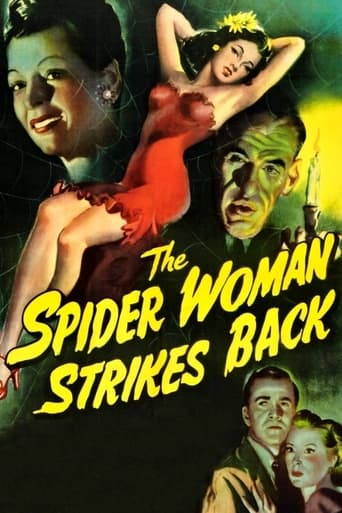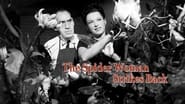kevin olzak
1946's "The Spider Woman Strikes Back" has no connection to the 1943 Sherlock Holmes feature "The Spider Woman" (a series was intended then wisely dropped). Gale Sondergaard is back of course, this time as Miss Zenobia Dollard, faking blindness as she milks her varied nurses of blood on a nightly basis (food for her poison-producing plants), making any number of excuses to explain away their absences. Brenda Joyce ("Strange Confession," "Pillow of Death," "Danger Woman"), best remembered as a very chaste Jane in five Sol Lesser Tarzan entries, makes for a dull heroine indeed, slow to catch on as to why she's developed a habit of sleeping in late, with former Creeper Rondo Hatton reduced in stature as mute manservant Mario, billed on the posters as 'The Monster Man,' doing little except skulk around in the dark, plus a bit of sign language (there is an indication that he may have some interest in this current nurse, but nothing comes of it). Kirby Grant is a colorless hero, and dependable Milburn Stone is wasted as an agricultural expert. Gale Sondergaard later acknowledged this film's reputation as a campy cult classic, but it never lives up to such high ideals; watchable, but far too slack in its pacing. Either overrated or underrated, this SHOCK! title made an astounding 8 appearances on Pittsburgh's Chiller Theater (only the fourth Universal to debut in the fall of 1965): Oct 9 1965 (following 1957's "The Giant Claw"), May 6 1967 (following 1956's "Pharaoh's Curse"), Apr 27 1968 (following 1966's "Track of the Vampire"), June 8 1974 (followed by 1965's "The Tenth Victim"), Aug 16 1975 (following 1967's "Son of Godzilla"), Apr 24 1976 (following 1965's "Nightmare Castle"), Dec 31 1977 (a triple bill, preceded by 1967's "Cauldron of Blood" and followed by 1937's "The Man Who Cried Wolf"), and Nov 19 1983 (solo).
Stephen Campello
Having read the other reviews of this movie, I am struck with the idea that people must have been expecting another Dracula or Frankenstein or The Black Cat. This movie is emblematic of dozens of B horror films of the period that were fun to watch but were hardly great art. It adds the distinction of great atmospherics: the "old dark house", the fabulously creepy Rondo Hatton, the deliciously evil Gale Sondegaard and the handsome, wholesome hero, Kirby Grant. Citizen Kane it ain't, but in the context of films like "Fog Island", "The 13th Guest", or "a Shriek in the Night" it was certainly more enjoyable. Plot wise, it incorporates elements of vampire flicks (blood sucking), wolf man flicks (rare plant research), and the good versus evil conflict within Rondo Hatton's character. Oscar material? Hardly, but great fun. Lighten up people!
The_Void
This film is not as well known as the earlier Universal flick The Spider Woman; and that's because this one isn't a part of the Sherlock Holmes series, isn't nearly as good, and actually has nothing at all to do with spiders. The plot focuses on a young girl that goes to become a nurse in a blind woman's house. However, it turns out that the woman is not really blind and is actually taking blood from the girl in order to feed it to her plant, which ties in with some plot about murdering cows. Aside from the fact that this film features Gale Sondergaard, I really don't see any similarity to The Spider Woman at all - she doesn't even reprise her role! The name, therefore, is just a cash-in on the success of the original. It's the sort of trick I'd expect from Italian films of the seventies and eighties, but not something often done by Universal studios! You can't blame them, though, as the film really does have no other selling points. It's a poor and rather dull tale. Nothing of interest happens for the entire duration, and I'm not surprised that it only runs for about fifty eight minutes. Overall, there's really no reason to track this film down - Sherlock Holmes fans will not be impressed!
MARIO GAUCI
Despite the title and the presence of two of Sherlock Holmes' most formidable nemesis (Gale Sondergaard and Rondo Hatton - hilariously named Zenobia and Mario respectively!), this is one lame film which has nothing whatsoever to do with one of the better Universal Sherlock Holmes entries. As a matter of fact, the story is weak, the premise far-fetched, the resolution predictable and the treatment uninspired! Besides, the fiery climax is clumsily executed and Hatton's fidgeting...er...sign language eventually gets on one's nerves! It's fair to say, then, that director Lubin fared much better with the other two 'horror' films he made for the studio - BLACK Friday (1940) and PHANTOM OF THE OPERA (1943), even if these weren't completely satisfying either...




